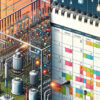Opinion piece
In a world where the rhythm of life is increasingly set by the pulse of technology, there exists a silent symphony being conducted in the very infrastructure that powers our daily lives. Long gone are the days of static, one-way power systems. Today, we stand on the brink of a new era where the grid is not just a network of cables and stations, but a dynamic, intelligent entity, responsive and adaptive to our needs.
Imagine, if you will, a ballet of electrons orchestrated by the subtle cues of digital technology, each step and leap calculated to deliver not just electricity, but a performance that maximizes efficiency, reliability, and sustainability. This is not just a utility network; it's a platform for innovation, a canvas for technologists and engineers to paint their vision of the future.
As we explore deeper into the concept of digitization within the power system, we encounter a landscape rich with opportunities. Central to this transformation is the integration of advanced digital technologies like IoT (Internet of Things), AI (Artificial Intelligence), and big data analytics into traditional power grids. These technologies act as the central processing units of our power systems, continuously gathering, analysing, and responding to data in real-time.
This transformation goes beyond simply upgrading old equipment; it's about rethinking the entire mechanism of power delivery. Smart meters, for example, do more than just record consumption. They send real-time data back to utilities, enabling not just improved demand management, but also allowing consumers to become active participants in their energy management through real-time feedback and adaptive consumption practices.
Furthermore, digitization enhances the resilience of the grid. By identifying and addressing issues before they escalate, smart systems can minimize downtime and avert failures. For instance, predictive maintenance technologies can forecast equipment malfunctions, allowing for proactive repairs and ensuring a consistent power supply.
Transitioning to these smarter systems also presents substantial challenges, including managing large volumes of data, ensuring cybersecurity, and upgrading an evolving grid infrastructure. Each step forward adds a piece to the mosaic of a fully digital power network, symbolizing both progress and the promise of a more connected and sustainable future.
The digitization of the power system does not merely represent an upgrade—it redefines how energy interacts with our daily lives. It transforms passive networks into active, intelligent systems that not only power our homes and businesses but also enhance our decisions and lifestyles.
The idea of digitalizing power systems also applies to helping consumers and taking care of the environment. Enhanced consumer engagement is facilitated through smart meters and home energy management systems that provide users with detailed insights into their energy usage patterns. This transparency not only encourages energy-saving behaviours but also enables consumers to take advantage of time-of-use tariffs, potentially lowering their energy costs.
Moreover, the environmental impact of digitizing power systems cannot be overstated. By optimizing energy distribution and reducing wastage, digital technologies contribute to a reduction in the overall carbon footprint of energy systems. For instance, smart grids can integrate more renewable energy sources like solar and wind, which are intermittent by nature, by better balancing supply and demand through real-time data analytics.
Additionally, the push towards electric vehicles (EVs) and the integration of EV charging stations into the grid highlights another layer of digitization. Smart charging stations can help manage the load on the grid by charging during off-peak hours, further promoting the use of renewable energy.
The road ahead involves scaling these technologies, addressing regulatory challenges, and ensuring that the benefits of digitization reach all segments of society. It is very important for policymakers, industry leaders, and consumers to collaborate in creating an ecosystem that supports these advancements while also addressing potential socio-economic disparities.
The digitization of power systems is a pivotal development in our pursuit of a more efficient, sustainable, and equitable energy future. It heralds a new era where energy not only powers our homes and industries but also empowers our collective environmental and economic well-being.
As we reflect on the themes of conformity and suppression highlighted in Pink Floyd's iconic song 'Another Brick in the Wall,' it's crucial to consider how these concepts apply to our field. In the world of energy and technology, it can be easy for individual creativity and innovative thinking to be overshadowed by the vast, uniform structures of industry norms and outdated practices. However, it is precisely these individual insights and unique perspectives that drive progress and lead to meaningful change.
Let us strive not to be just another brick in the wall of conventional energy solutions. Instead, let's challenge ourselves to break down the walls of conformity. If we encourage people to be creative and unique, we can create energy solutions that are not only efficient but also helpful and inclusive.






All comments are moderated before being published. Inappropriate or off-topic comments may not be approved.